Posted: 10 Feb 2012 03:20 PM PST   Plenty has gone on in the Android world this week and we have just a few leftover morsels to digest in our Friday edition of Android Overload. But first, TGIF, guys. Another long week ends with what will hopefully be a good weekend for all. Speaking of the weekend, have you all noticed our new weekend staff? They’ll be here to cover for the rest of the crew as we recover from our own personal Android overloads. So play nice!
|
Posted: 10 Feb 2012 02:20 PM PST   AT&T is about to double the fee associated with upgrading to a new device. The current cost of $18 will double to $36 effective this Sunday, February 12th. AT&T has been sending around email notices to customers and has informed dealers of the change, which is in response to an increase in “the overall costs associated with upgrading to a new device.” Official word has yet to trickle out, but courtesy of BGR you can get a look at the document reaching retail locations. [via BGR] |
Posted: 10 Feb 2012 01:48 PM PST   For those of us from large metropolitan areas, we often take our 3G, if not 4G, coverage for granted, but the number of areas in the United States not serviced by a high-speed mobile network may surprise you. Each splotch of black on the above map represents an area of the US population that was not receiving at least 3G coverage as of January 2012. The splotches become bigger and bigger as you move out west. The interactive map (embedded below) allows you to zoom in and get a better idea of just how many citizens are affected. The numbers are usually rather low, ranging from a handful of people up to a few thousand, but they add up. Most of these areas are less densely populated with wide gaps in infrastructure, but some can be found just miles from the biggest cities in the country, including New York. The bigger issue is that mobile providers continue to upgrade their networks in the big markets while ignoring the needs of those stuck with 2G coverage, a problem the Mobility Fund is hoping to call attention to through their startling look at US mobile coverage. While we sure do love our 4G connection speeds, other shouldn’t have to miss out based on where they live. [via WinSource | Thanks, Samantha!] |
Posted: 10 Feb 2012 01:08 PM PST 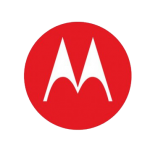  Apple is suing Motorola over a patent licensing agreement the company soon to be acquired by Google holds with Qualcomm. The suit stems from a legal battle between the two parties currently being mulled by a German court. Motorola is suing Apple for infringement of European Patent No. 1 010 336 (U.S. Patent No. 6,359,898), but Apple’s suit filed with a district court in California claims that a previous licensing agreement between Motorola and Qualcomm entitles the Cupertino-based company as a third-party beneficiary. Apple uses Qualcomm MDM6610 baseband chip in the CDMA version of the iPhone 4S and is arguing that it’s agreement with the chipmaker includes fees for utilizing the licensed patent. Apple is seeking to have the German lawsuit thrown out, as it sees the legal action as a breach of contract between the parties. In the view of Apple’s legal department, Motorola has exhausted its rights to the patent in both the US and Europe. Suing a company over a patent that they have cross-licensed as part of an agreement with a third party seems like a pretty big oversight on Motorola’s part, but that’s why we aren’t the ones rendering final judgement. [via Reuters, TheNextWeb] |
Posted: 10 Feb 2012 12:43 PM PST   Acer has taken the wraps off of one of their products headed to Mobile World Congress a couple weeks early. The Android 4.0 Acer CloudMobile will be among the first devices to support the AcerCloud service and will be available to consumers in late 2012. The handset sports a 4.3-inch HD display, will feature Dolby sound, and measures in at 9.9mm thick. What little we know of the phone comes from the announcement that it has picked up a nod from the IF Design awards. Acer is looking towards the CloudMobile to be their flagship Android device, and we’ll be live in Barcelona with a first look. MWC is only two weeks away now. Can you feel the excitement? [via PocketLint] |
Posted: 10 Feb 2012 11:54 AM PST  There are reports that Amazon will launch its second Kindle Fire model along with an update to the 7-inch version by mid-year. It was originally rumored that two tablets would be launched by the e-retailer, the 7-inch model which saw a release back in the fall and a 10-inch model, which never surfaced. Since then it was suggested that Amazon pushed back plans for the 10-inch slate once codenamed “Hollywood” in favor of first releasing an 8.9-inch model. Estimates calculated by Pacific Crest analyst Chard Bartley take the new model into account, raising shipment forecasts in anticipation of the larger device. The number grew from 12.7 million units to 14.9 million on the basis of both a new 7-inch and 9-inch Kindle Fire. [via BGR] |
Posted: 10 Feb 2012 10:16 AM PST  For quite some time, the United States mobile market has been dominated by four main players: Verizon Wireless, AT&T, T-Mobile, and Sprint. The past few years we’ve seen consolidation, with Verizon acquiring Alltel, and more recently AT&T failing to acquire T-Mobile. Each carrier tries to brand themselves a certain way, but are they successful? I’m curious to hear what our readers think about each of the Big 4 American mobile carriers.  From a few years back, I would have said:
Remember: before Android, Verizon was considered the most locked down carrier on the planet. That may (still) be partially true, but Verizon was only 2nd to T-Mobile in adopting Android. Back then, AT&T seemed like they would NEVER get an Android phone. There was also a time when WebOS was going to be the next big thing. Nobody cared about Android, Palm stock was surging, and Sprint was lined up to be the exclusive launch partner of the Palm Pre. For awhile there, I think Sprint had the best lineup of Android devices. The EVO was a hit and getting the Nexus S was huge… but the playing field has (at least) seem to level out in terms of product offerings. Times change. Opinions fluctuate. But I want to know, RIGHT NOW, what is your opinion of each carrier? Hit up the comments and let us know… Please format your comment like this:Take Our Poll |
Posted: 10 Feb 2012 09:46 AM PST   After Verizon posted details about a new software upgrade heading out to Motorola DROID BIONIC users, we figured it’d only be mere days before folks actually started getting the update. Well here we are on the last day of the week and our inbox was flooded with reports from users that they’re being notified of the update being available. Here’s a quick primer on what’s changing: he changelog states that V-Cast Apps and Amazon MP3 are both preloaded. We’ve also got improvements for data connectivity and stability, WiFi mobile hotspot fixes, improvements in overall device stability and a lot more. The full changelog found in this PDF file should give you a great idea of what to expect.And the rest of it an be had in this file. Be sure to check for the update and enjoy the taste of sweet, sweet progress. [Thanks to everyone who sent this in!] |
Posted: 10 Feb 2012 09:33 AM PST 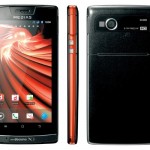  Another NEC phone with a weird name is headed our way, folks. NTT DoCoMo is gearing up to launch the NEC Medias LTE N-04D. As its name implies, it’ll be a 4G LTE device aimed toward the high-end market. It has a 1.2Ghz dual-core processor, a 4.3 inch 720p HD display and a TV tuner for tube on the go. It’ll also have Bluetooth 4.0 which is needed to interface with Casio”s G-SHOCK Bluetooth watch. I really, really love NEC’s phones but unfortunately I’ll never have the chance to own one unless I make a move to Japan. If you happen to reside in the land of the rising sun, though, look forward to its launch on NTT next week. [NTT DoCoMo via Engadget] |
Posted: 10 Feb 2012 08:56 AM PST   LG’s sending out press invites to members of the media for a showing at Mobile World Congress where they’ll show off “revolutionary new smartphones for 2012.” Just as a reminder, we’re expecting to see some great phones from LG including the 5 inch LG Optimus Vu, the quad-core LG X3 and the LG P700 and LG P880. We’ll be front row and center for all of their announcements at Mobile World Congress so keep us in mind come February 27th when all of this is going down. |
Posted: 10 Feb 2012 08:43 AM PST   When the Motorola Droid hit the scene, the whole Android landscape changed. Since then the marquee device has fallen from the spotlight, but it’s back in a big way for the fourth installment. The Motorola Droid 4 continues to improve upon the design of the QWERTY-slider handset, upping the specs yet again and adding in a first for the line, 4G LTE. Motorola has again made strides to improve the keyboard and has added in a few new software twists to round out the latest edition of the Droid. Is it the best Droid yet? Read on to find out. HardwareAt first glance, the Motorola Droid 4 could be mistaken for a much fatter Droid RAZR (Droid RAZR MAXX MAXX?). Its 12.7mm thickness — same as the Droid 3 — won’t hold a candle to the RAZR’s 7.1mm profile. At a millimeter thinner than the original Droid, the line isn’t doing much to slim down. The silhouette of the Droid 4 features the same angled corners found on the RAZR and XYBOARDs, an element that seems to define Moto’s current Android crop. A 4.0-inch display holds par with the Droid 3, which was the first in the line to move up from the 3.7-inch screen size. It’s qHD (540×960 resolution) in this case. Inside the Droid 4 rests a dual-core TI OMAP 4430 processor clocked at 1.2GHz, 1GB of RAM, and 16GB of internal storage. The phone sports an 8MP camera with LED flash and 1080p video recording and a 1.3MP front-facing camera. Also found are microUSB and microHDMI ports, a volume rocker (but no dedicated camera key), and 3.5mm headset jack. The hardware alone makes this the most powerful member of the QWERTY Droid branch of phones, and it definitely counts. Gaming and web rendering hardly lag and navigating through the phone’s UI is a breeze.  The phone’s 4G LTE connectivity was nice and zippy, just like we have come to expect from Verizon’s network. Call quality was good and connectivity was a non-issue. 3G/4G network switching showed no hiccups. The Droid 4 does feature removable microSD storage (my review unit came with none pre-installed) up to 32GB, which is accessible by removing the phone’s back cover. A special key, provided in the box, is needed to gain access. The phone also utilizes a microSIM for 4G LTE connectivity, which can be found in the same location. The battery, however, is not removable. This isn’t necessarily a bad thing, but the 1785mAh battery installed is a far cry from the 3300mAh of the Droid RAZR MAXX. The ability to swap in a fresh battery or install an extended one will be missed, especially with extra elements such as keyboard backlighting drawing even more juice.Keyboard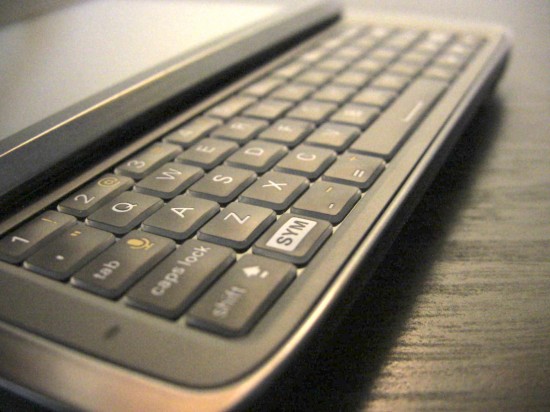 Because this is a Droid phone, we should dedicate a special section to the ever-improving keyboard. I am on the record as someone who actually liked the original Droid’s keyboard and missed the D-pad when they did away with it, but I can’t deny that Moto keeps making this thing better and better. The Droid 4 carries over the five-row QWERTY from the Droid 3, dedicating a full row for the numbers and other symbols. The layout is the most similar to a computer keyboard yet, carrying over many of the same keys and leaving them in their familiar places. 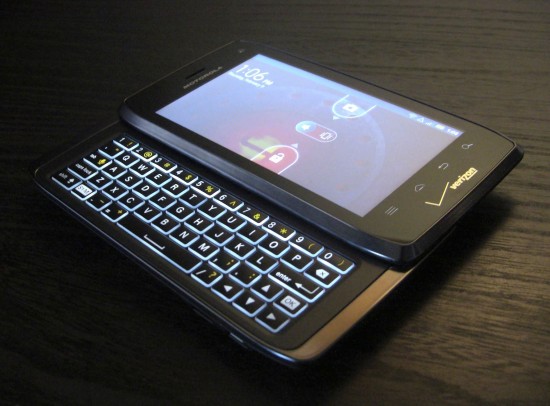 Keys are isolated (no membrane keyboard) and each press results in a satisfying click. Ample spacing really lets the thumbs fly without much fear of hitting the wrong key, but you will need to adjust your strokes slightly. The whole keyboard feels a bit off-center. The left-hand thumb needs to reach out a bit to hit the space bar. In fact, most keys seem shifted just a bit too far to the right. After getting used to the layout, this shouldn’t be a huge problem. SoftwareIn the software department, the Motorola Droid 4 again takes plenty of cues from the Droid RAZR. The phone runs Android 2.3.6 with the most recent version of Motorola’s custom interface on top. Nothing is incredibly new about the interface, which should be immediately recognizable for anyone who has used a recent Motorola handset. There is enough in common here with other Android interfaces that things won’t feel too foreign to most users. What you get is Moto’s custom look with a selection of widgets for social networking, favorites, and more. You will also find two features Motorola is emphasizing in their latest product releases, Smart Actions and MotoCast.Smart Actions are designed to automate certain functions in order to achieve things like better battery life and profiles for home and work. For starters there is a list of pre-defined actions, but new ones can be created based on specific criteria. The phone will also learn from your interactions with the handset and suggest new automations. Turn your WiFi off every time you leave the house? The Droid 4 will suggest a Smart Action that uses GPS to detect when you leave home and then automatically switch off WiFi. We’ve seen the functionality in previous third-party apps, but the ability for Moto’s app to learn new actions makes it particularly intriguing. MotoCast is Motorola’s version of a personal cloud. You set up the devices on your network by installing certain software and designating shared folders to gain access to your files from your mobile or vice versa. You can share audio, video, and photos directly or share files such as Word documents or PDFs. Forgot to forward that important spreadsheet to your work email? Grab it via MotoCast. It’s pretty simple to use and depending on network speeds quite fast. Motorola’s stock web browser isn’t the fasted we have ever used, but on the Droid 4 there were no complaints. It was able to quickly render web pages and scrolling showed little lag. Particularly impressive was the phone’s ability to play a YouTube video within a page’s content while scrolling and zooming the page. The video didn’t skip a beat. Other included software ranges from Blockbuster to a demo for Madden NFL 12, which looked great and ran smoothly. There does seem to be an abundance of pre-installed applications, which some users won’t mind and some will take a distaste to. Overall the software didn’t do much to blow us away, but it felt solid. Things worked how you would expect them to work and were helped along nicely by the phone’s strong hardware. Camera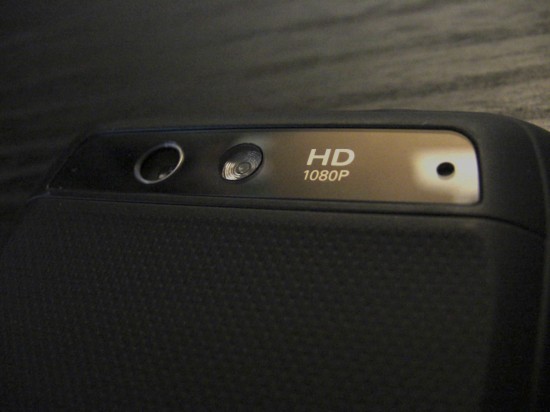 The Droid 4′s camera was surprisingly impressive. After a bit if fiddling around I managed to snap off a few nice shots. The 8MP camera doesn’t knock you over with its quality but the images had a certain look to them that was aesthetically pleasing. Pictures were snapped almost instantly and the phone’s auto-focus did a pretty good job of reeling in the photo’s subject.  The camera features a macro mode among others plus a selection of effects to spice up your pictures. Also included were modes for panorama, multi-shot, and timed photos.  Video left a bit to be desired, but its 1080p quality at 30fps was more than adequate. Don’t expect the Droid 4 to become a go-to HD camcorder, but for capturing a YouTube video or one of life’s random events it gets the job done. ConclusionIs this the best Droid yet? In many ways, yes. But it won’t revolutionize the phone landscape in the same was as the original. The phone doesn’t feel quite fresh enough to get us raving about it, but it doesn’t do much wrong at the same time. Given its similarities to the Droid RAZR, many will want to compare the two and see which is right for them. For the text addict that isn’t too concerned about having a thicker phone with a bit more heft to it, the Droid 4 is just the ticket. For those looking for something with the same functionality but in a thinner form factor, the RAZR may be a consideration. The QWERTY Droid has become a stalwart of Verizon’s line and looks to be a real workhorse in its latest revision. We’d like to see a bit more innovation with the form factor on Motorola’s end, but the Droid 4 proves that the line is here for the long haul. |
Posted: 10 Feb 2012 08:43 AM PST   The Samsung Galaxy Note was originally available in two different colors but it seems like Samsung has more of a trinity in mind. They’ll soon be introducing a pink version of the Galaxy Note. It’s “Berry Pink” to be specific, though I never really put much stock into a color’s “extended” name. In any case, those who find themselves attracted to this color will be glad to know that it’s on its way, though we can’t anticipate which markets will get it outside of Korea and likely Europe. [GSM Arena] |
Posted: 10 Feb 2012 07:56 AM PST  Imagine being able to get a phone upgrade every six months (best value for least amount of time) over the life of a 24 month contract. Do I have your attention yet? UK carrier Phones4U has introduced a new model called JUMP, or “Just Upgrade My Phone.” "Technology is moving fast and innovative handsets are launching all the time on the market but to date there’s been a disconnect between the frequency of smartphone releases and the length of mobile phone contracts on offer.With JUMP, you have the option of paying more per month in order to get a new phone after however long you want. Let’s say, for instance, that we want to sign a 24 month contract and upgrade to an iPhone 4S (we know, but just bear with us).  A £2.99 charge on top of your monthly rate of £35 for a Galaxy Nexus would have you paying £37.99 per month, split between airtime (£15.00 a month) and the JUMP agreement (£22.99 a month). If you decide to get a new phone after 6 months, they’ll subtract six months’ worth of JUMP payments from the overall amount you’d have paid for JUMP over the life of the contract. You then trade your old phone(s) and subtract the amount gained from those from the remaining JUMP balance. You’ll get a new rate plan depending on which phone you get + the standard JUMP pricing + new supplemental JUMP charges, and from there you do the same for your next phone, and so on and so forth. You can keep doing this until your contract expires. You won’t be getting free phones as you would for upgrading a standard contract but being able to get such discounts on new phones without having to pay full MSRP is worth it. If you’re still confused, consider Recombu’s breakdown of it below (where my figures were initially pulled from): In the examples we’ve been given Phones 4u looks at a price plan for an iPhone 4S with £20 worth of minutes, messages and data etc:I know I wouldn’t mind being able to upgrade every six months without incurring early termination fees or buying devices outright. We don’t see many contract carriers, in the UK or otherwise, catching on to this but we will certainly keep our fingers crossed. |
Posted: 10 Feb 2012 07:05 AM PST 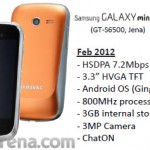  A sequel to the Samsung Galaxy Mini has been leaked and it’s simply being called the Samsung Galaxy Mini 2 (S6500). It’s a low-end device aimed at the affordable market but depending on pricing, it could be a decent phone for first time smartphone owners. It will have an 800MHz processor, a 3.3 inch HVGA display, 3GB of internal storage, a 3 megapixel camera and Android 2.3. The device is reportedly coming sometime this month and it’s almost certain that Mobile World Congress will serve as a launch platform for it. We’ll see. Stay tuned for coverage if you happen to find yourself interested. [GSMArena] |
Posted: 10 Feb 2012 05:55 AM PST 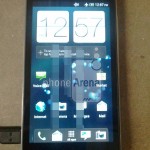 [Update]: Looks like it’s a Verizon phone, folks. And considering the back plate design, it isn’t too farfetch’d to to suggest that this could be the DROID Incredible 3. HTC may also introduce an international version at Mobile World Congress like they did with the Incredible S/DROID Incredible 2 last year. PhoneArena got their hands on a major gallery of a new HTC device that, as of yet, has no name. It’ll reportedly be a 4.3 inch Super AMOLED device and is expected to be the first HTC device to ship with Android 4.0 and, by extension, HTC Sense 4.0. It has an interesting design but other than that it looks to be your ordinary high-end HTC phone.  We’re working with a 1.2GHz dual-core Snapdragon processor, 1GB of RAM, an 8 megapixel camera, a VGA front camera, 4G LTE and more. Once upon a time it was easy to point out who might be getting an LTE phone as there was only one carrier with the technology in major markets, but Verizon and AT&T now have operating LTE networks and Sprint is said to be launching its LTE network in the middle of this year. We, of course, hope to see this phone announced at Mobile World Congress as the devices rumored to be showing up there don’t exactly seem to set the world on fire. To be fair, neither does this – it fits in that “this phone is pretty much the same as all our other phones” cateory, but perhaps the addition of Android 4.0 and the latest version of Sense will set itself apart. Head to PhoneArena for the full gallery of images. |
Saturday, February 11, 2012
Subscribe to:
Posts (Atom)